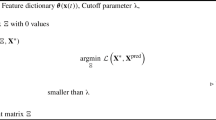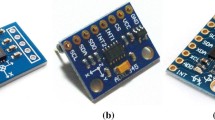Abstract
The paper gives a survey of the history of damping methods for balances. Representation on Egyptian drawings demonstrate that the person performing the weighing shortened the measuring time by holding the suspension cords and touching the beam. By means of delimiters, the Romans constricted the deflection amplitudes. In the 19th century, the movements of precision balances were damped with a brush. For analytical balances, locking mechanism were developed, often combined with levers lifting the weighing scales and the beam in order to relieve the knife-edges. Half-arresting was used to curtail weighings. Air damping was invented by Arzberger in 1875, and eddy current damping by Marek in 1906. In electronic balances, lag, lead and filter elements and absorptive attenuators are used. For digital balances, the fast-reacting nullification of eddy signals is applied.
Similar content being viewed by others
References
W. Felgenträger, Feine Waagen, Wägungen und Gewichte. Berlin 1932, p. 3.
Th. Gast, T. Brokate and E. Robens, Massebestimmung. In: M. Kochsiek, M. Gläser (Eds), Mass Determination, Wiley-VCH, Weinheim 1999, in press.
H. R. Jenemann, Mass und Gewicht, (1992) 470 and 509.
H. R. Jenemann, Berichte zur Wissenschaftsgeschichte, 20 (1997) 1.
C. H. Massen, J. A. Poulis and E. Robens, High-speed weighing (in press).
H. R. Jenemann and E. Robens, Thermochim. Acta, 152 (1989) 249.
C. J. Williams, American Laboratory, (1969) 1163.
Y. Kobayashi, Y. Nezu, K. Uchikawa, S. Ikeda and H. Yano, Bulletin of NRLM, 33 (1984) 7.
N. Mendelssohn, Annalen der Physik, 29 (1808) 153.
C. F. Plattner, Die Probirkunst mit dem Lötrohre, Leipzig 1833, p. 33.
M. Gläser, Massekomparatoren. In: M. Kochsick, M. Gläser (Eds), Massebestimmung, VCH, Weinheim 1997, p. 442.
F. Arzberger, Annalen der Chemie, 178 (1875) 382.
H. R. Jenemann, Blätter für Technikgeschichte, 49 (1987) 7.
P. Curie, Comptes rendus hebd. séances Acad. Sci., 108 (1889) 663.
H. R. Jenemann, Mitt. d. Oberhessischen Geschichtsvereins Giessen, 66 (1981) 5.
H. R. Jenemann, Z. f. Unternehmensgeschichte, 31 (1986) 117.
W. Kuhn, E. Robens, G. Sandstede and G. Walter, Methods of the elimination of weighing troubles due to convection in a microbalance. In: C. H. Massen, H. J. van Beckum (Eds), Vacuum Microbalance Techniques, Vol. 1. Plenum Press, New York 1961, p. 1.
W. C. Tripp, R. W. Vest and N. M. Tallan, System for measuring microgram weight changes under controlled oxygen partial pressure to 1800°C. In: P. M. Waters (Ed.), Vacuum Microbalance Techniques, Vol. 4. Plenum Press, New York 1965, p. 141.
O. Frölich, Die Entwicklung der clektrischen Messung. Braunschweig, 1905, p. 17.
W. Marek, Österreichische Zentral-Zeitung für Optik und Mechanik, 1 (1906) 5.
R. F. Walker, Microbalance techniques for high temperature applications. In: M. J. Katz (Ed.), Vacuum Microbalance Techniques, Vol. 1. Plenum Press, New York 1961, p. 87.
E. A. Gulbransen and K. F. Andrew, An enclosed physical chemistry laboratory: The vacuum microbalance. In: M. J. Katz (Ed.), Vacuum Microbalance Techniques, Vol. 1. Plenum Press, New York 1961, p. 1.
R. J. Kolenkow and P. W. Zitzewitz, A microbalance for magnetic susceptibility measurements. In: P. M. Waters (Ed.), Vacuum Microbalance Techniques, Vol. 4. Plenum Press, New York 1965, p. 195.
H. Mayer, R. Niedermayer, W. Schroen, D. Stünkel and H. Göhre, On some modification of a torsion microbalance for use in ultrahigh vacuum. In: K. H. Behrndt (Ed.), Vacuum Microbalance Techniques, Vol. 3. Plenum Press, New York 1963, p. 75.
H. R. Jenemann, The early history of balances based on electromagnetic and electrodynamic force compensation. In: J. U. Keller, E. Robens (Eds), Microbalance Techniques, Proc. of the 25th Conference on Vacuum Microbalance Techniques 1993 Siegen, Multi-Science Publ., Brentwood 1994, p. 25.
H. R. Jenemann, Die Waage des Chemikers — The Chemist's Balance. DECHEMA/GDCh, Frankfurt 1997.
R. L. Schwoebel, Beam microbalance design, construction and operation. In: A. W. Czanderna, S. P. Wolsky (Eds), Microweighing in Vacuum and Controlled Environments. Elsevier, Amsterdam 1980, p. 59.
F. A. Mauer, Rev. Sci. Instr., 25 (1954) 598.
L. Cahn and H. R. Schultz, The Cahn recording gram electrobalance. In: K. H. Behrndt (Ed.), Vacuum Microbalance Techniques, Vol. 3. Plenum Press, New York 1963, p. 29.
W. E. Boggs, The adaptation of the Cahn electrobalance control system to the automatic operation of a quartz-beam vacuum microbalance. In: A. W. Czanderna (Ed.), Vacuum Microbalance Techniques, Vol. 6. Plenum Press, New York 1967, p. 45.
Th. Gast, Microweighing in vacuo with a magnetic suspension balance. In: K. H. Behrndt (Ed.), Vacuum Microbalance Techniques, Vol. 3. Plenum Press, New York 1963, p. 45.
Author information
Authors and Affiliations
Rights and permissions
About this article
Cite this article
Gast, T., Jenemann, H.R. & Robens, E. The Damping of Balances. Journal of Thermal Analysis and Calorimetry 55, 347–355 (1999). https://doi.org/10.1023/A:1010182610908
Issue Date:
DOI: https://doi.org/10.1023/A:1010182610908




